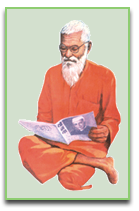Swami Keshwanand Rajasthan Agricultural University, Bikaner
स्वामी केशवानन्द राजस्थान कृषि विश्वविद्यालय, बीकानेर
Quick Links
Quick Links
Introduction
Swami Keshwanand, after whom the RAU has been renamed as Swami Keshwanand Rajasthan Agricultural University, Bikaner (SKRAU, Bikaner) vide Gazette notification No. F. 4 (2) vidhi/ 2/ 2009 dated June 09, 2009, was born at the village Magloona in Sikar district of present-day Rajasthan in the year 1883. His actual name was Birama. The famine of 1899 forced the 16-year-old Birama to leave the desert region and move to Punjab in search of livelihood. Driven by an ineffable spiritual quest, he became a sanyasi in 1904 and was inducted into the Udasin sec. He commenced his education at the Sadhu Ashram Fazilka. He learned the Hindi and Sanskrit languages and the Devanagari and Gurmukhi scripts at the Ashram. At the Kumbha Mela held at Prayag in 1905, Mahatma Hiranandji Avadhut conferred on Birama the new name “Swami Keshwanand”.
Swami Keshwanand lived an accomplished life of myriad facets such as freedom fighter, educator, Hindi propagator and social reformer.
Swami Keshwanand lived an accomplished life of myriad facets such as freedom fighter, educator, Hindi propagator and social reformer.

The freedom fighter
After the Jalianwalla Bagh Massacre of 1919, Swamiji participated in the non-cooperation movement under the leadership of Mahatma Gandhi for which he was imprisoned for two years (1921-1922) at Ferozepur. In 1930, he was given charge of Congress activities in Ferozepur district. He was again arrested the same year, but was soon released pursuant to the Gandhi-Irwin pact.
The educator
Swami Keshwanand, founded more than 300 schools, 50 hostels and innumerable libraries, social service centers and museums. In 1911, within a few years of his initiation into the Udasin Dasnami sect as a sanyasi, Swami Keshawanand started the “Vedant Pushp Vatika” library within the precincts of the Sadhu Ashram Fazilka. The following year, he started a Sanskrit school at the same place. In 1932, Swami Keshwanand was made director of the Jat School, Sangaria, which was at the verge of closure for want of funds. He was successful in averting the closure of the school, which was renamed Gramothan Vidyapith, Sangaria in 1948. Within the premises of this school, Swami Keshwanand developed a museum with a valuable collection of rare documents, paintings and antiques. He undertook a large-scale, successful project to green the surroundings of the school, which was located in one of the most arid regions of India. It gradually developed into present day institution- Gramothan Vidyapith, Sangaria, an inspiration for educators far and wide.
Propagator of Hindi
Swami Keshwanand felt that the knowledge of the Hindi language is a must to keep the country united and to educate the public about nationality. He started the programme of spreading Hindi through ‘Hindi Forum’ that he founded in 1920 at Abohar in of Punjab. This forum was later renamed “Sahitya Sadan, Abohar”. In 1933, he started a press named “Deepak” at Abohar, which published material in Hindi language that was distributed either free or at a very nominal price. He organized the 30th All India Hindi Sahitya Sammelan at Sahitya Sadan, Abohar, in 1941. Swami Keshwanand was a long- time member of the Hindi Sahitya Sammelan, Allahabad. He either himself wrote, or arranged for the translation into Hindi, of around 100 books. Through immense efforts over a course of 11 years, he arranged for the publication of the Hindi edition of the book “History of Sikhs” in 1954. In 1942, he was honoured with the “Sahitya Vachaspati” for his contribution towards propagating and popularizing Hindi.
The social reformer
It was Swami Keshwanand’s long time endeavour to eradicate social evils like untouchability, illiteracy, child marriage, alcohol abuse, moral dissipation etc. Swami Keshwanand’s deep understanding of the rural society of the desert region can be gleaned from his book “Maru Bhumi Seva Karya”. In this book, he has explained the peculiarities of the Desert region, identified the problems and suggested rational and feasible solutions.
Swamiji was great supporter of girls’ education. He started a girl school viz; Gramothan Vidyapeath in Sangriya on August 09, 1917. Today, Sangriya is one of the important hub of the educational activities of Rajasthan and India and is studded with colleges and schools Swami Keshwanand college, Swami Keshwanand Memorial Public School, Gramothan Vidyapeath’s schools/ colleges viz; Home Science Women’s College, College of Education, Higher Secondary School, Girls Higher Secondary School, Primary Girls School, Krishi Vigyan Kendra (KVK) and Sir Chhotu Ram Museum.

Swamiji was a member of the Rajya Sabha for two consecutive terms (1952-58 and 1958-64). The luminous soul of Swami Keshwanand left for heavenly abode on September 13, 1972. Government of India, issued a commemorative postage stamp in his honour on August 15, 1999.
Associated with the name of Swamiji, SKRAU pays tribute to this great educational, social and spiritual personality and reaffirms its commitment to of education and rural upliftment that was so coveted and pursued by the great soul.

